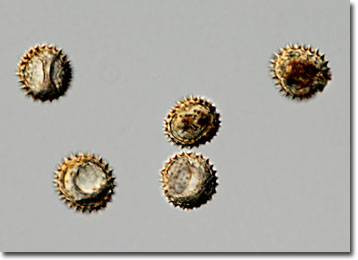Differential Interference Contrast Image Gallery
Ragweed Pollen
Ragweed pollen is the primary cause of the recurrent bouts of sneezing, nasal congestion, and itchy eyes known as hay fever in the United States. The coarse annuals depend on the wind for cross-fertilization and since a single plant may produce a billion grains of pollen during a season, many of the grains inadvertently find their way into the noses and throats of humans.

Approximately fifteen species in the genus Ambrosia are commonly referred to as ragweed. The plants feature rough stems, small yellow-green flowers, and lobed leaves. They often grow in disturbed soil that cannot support other types of vegetation and flourish in conditions of low humidity and high heat. In North America, ragweed is most abundant in the midwest and central United States, but few areas are free from it altogether. However, Portland, Oregon and Seattle, Washington, which claim that they do not have ragweed seasons, could be considered safe havens for hay fever sufferers.
In most areas of the United Sates, ragweed season ranges from mid-August through November or until the first frost, with levels generally peaking in the middle of September. During these periods, those with pollen allergies should take precautions to reduce the intensity of hay fever attacks. Since pollen counts are highest in between five and ten in the morning, outside activities should be avoided until the afternoon. Also, windows should be kept closed and an air conditioner used if needed, rather than fans. If exposure to ragweed pollen is unavoidable, however, a wide variety of products including antihistamines, decongestants, and steroid nose sprays are available to help alleviate symptoms.
